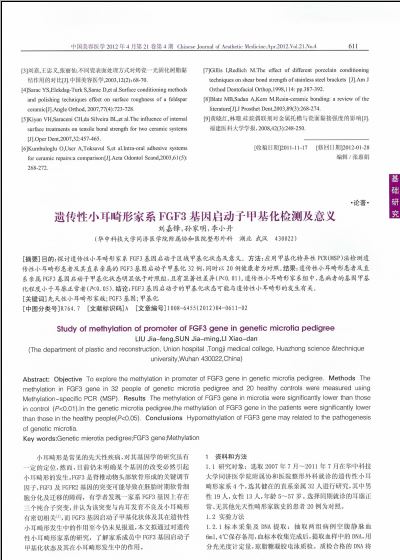遗传性小耳畸形家系FGF3基因启动子甲基化检测及意义(2)
 |
| 第1页 |
参见附件。
3.4 笔者的研究发现在FGF3基因启动子上存在低甲基化状态,提示可能与小耳畸形的发生有关,其机制可能是因为FGF3基因具有基因剂量效应,即剂量达到一定阈值基因才能发挥正常功能,所以同一家系不同成员中存在外显不全或表观度变异。此外,基因低甲基化也可能引起患侧组织染色体重构,并进而导致细胞表型的变化。进一步的研究将详细了解哪些具体位点的甲基化改变,以及FGF3整体的低甲基化改变对基因表达及耳软骨细胞发生及迁移的影响。
[参考文献]
[1]Tekin M,Hi?mi BO,Fitoz S,et al.Homozygous mutations in fibroblast growth factor 3 are associated with a new form of syndromic deafness characterized by inner ear agenesis,microtia,and microdontia[J].Am J Hum Genet,2007,80(2):338-344.
[2]朱军,王艳萍,梁娟,等.1988-1992全国先天性无耳及小耳畸形发病率的抽样调查[J].中华耳鼻咽喉科杂志,2000,35(1):62-65.
[3]庄洪兴,蒋海越,潘博,等.先天性小耳畸形的皮肤软组织扩张器法外耳再造术[J].中华整形外科杂志,2006,22(4):286-289.
[4]Pan B,Jiang It,Guo D,et a1.Microtia:ear reconstruction use tissue expander and autogenous costal cartilage[J].J Plast Reconstr Aesthet Surg,2008,61(Suppl 1):S98-S103.
[5]Alasti F,Sadeghi A,Sanati MH,et al. A Mutation in HOXA2 Is Responsible for Autosomal-Recessive Microtia in an Iranian Family[J].Am J Hum Genet,2008,82(4):982-991.
[6]Zhang Q,Zhang J,Yin W.Environmental and genetic factors associated with congenital microtia:a case-control study in Jiangsu,China,2004 to 2007[J].Plast Reconstr Surg, 2009,124(4):1157-1164.
[7]Aoyama T,Okamoto T,Fukiage K,et al ......
您现在查看是摘要介绍页,详见PDF附件(1164kb)。